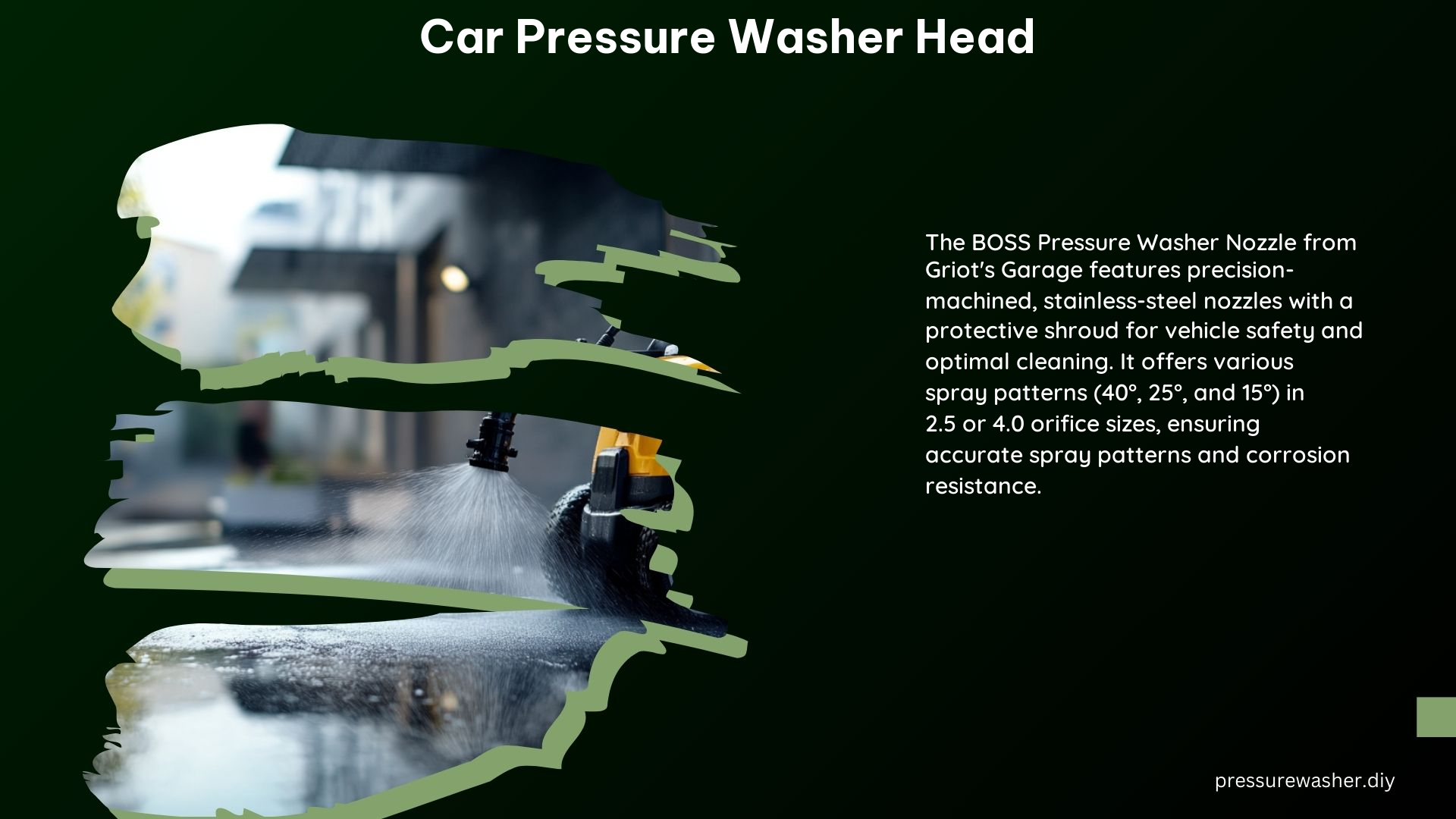When it comes to maintaining the pristine appearance of your car, a pressure washer can be an invaluable tool. However, the success of your car washing endeavor largely depends on the type of pressure washer head you use. In this comprehensive guide, we’ll delve into the intricacies of car pressure washer heads, providing you with the technical knowledge and practical tips to ensure a flawless car cleaning experience.
Ideal Spray Nozzle Degree for Washing a Car
The ideal spray nozzle degree for washing a car is typically 40 degrees, which is usually represented by a white nozzle. This angle provides a wide enough spray pattern to effectively clean the car’s surface without damaging the paint or other delicate areas. The 40-degree nozzle is versatile, allowing you to tackle both the initial cleaning and the application of soap with equal efficiency.
Using a 40-Degree Nozzle for Applying Soap

A 40-degree nozzle is an excellent choice for applying soap when pressure washing a car. This nozzle angle creates a wide spray pattern that helps to distribute the soap evenly across the car’s surface, ensuring thorough coverage and effective cleaning. The wide spray pattern also helps to minimize the risk of water spotting or streaking, which can occur with a more concentrated spray.
Orifice Size and Its Effect on Pressure and Water Flow
The orifice size of a pressure washer nozzle is a critical factor that affects the pressure and water flow of the system. A larger orifice size, such as 4.0, will result in a higher water flow rate but lower pressure, while a smaller orifice size, like 2.5, will produce higher pressure but lower water flow.
To illustrate this, let’s consider a scenario where you have two nozzles with different orifice sizes:
| Orifice Size | Water Flow Rate | Pressure |
|---|---|---|
| 2.5 | Lower | Higher |
| 4.0 | Higher | Lower |
The 2.5 orifice size nozzle will deliver a higher pressure, making it more suitable for tackling stubborn dirt and grime, while the 4.0 orifice size nozzle will provide a higher water flow rate, which can be beneficial for rinsing large surface areas more efficiently.
Technical Specifications of Car Pressure Washer Heads
When selecting a car pressure washer head, it’s essential to consider the following technical specifications:
Material
High-quality pressure washer nozzles are typically made from stainless steel and brass, ensuring durability and resistance to rust and corrosion. These materials can withstand the high-pressure water flow and the harsh cleaning chemicals used in car washing.
Inlet Connection Size
The inlet connection size of car pressure washer heads is usually 0.25 inches, with a National Pipe Tapered (NPT) type connection. This standardized size ensures compatibility with most pressure washer wands and hoses.
Spray Patterns
Pressure washer nozzles come in a variety of spray patterns, including 0°, 15°, 25°, 40°, and 65°. Each pattern is suited for different cleaning tasks, with the 40-degree nozzle being the most versatile for car washing.
Orifice Sizes
As mentioned earlier, orifice sizes can vary, with common sizes being 2.5 and 4.0. The orifice size directly affects the pressure and water flow of the pressure washer, so it’s essential to choose the right size for your specific cleaning needs.
DIY Tips for Using Car Pressure Washer Heads
-
Choose the Right Nozzle: Select a nozzle with the appropriate spray pattern and orifice size for your specific cleaning needs. The 40-degree nozzle is a great all-around choice for car washing.
-
Use the Correct Soap: Invest in automotive soap specifically designed for pressure washers to prevent damage to the car’s paint. Avoid using household detergents, as they can be too harsh and strip the car’s protective coatings.
-
Maintain a Safe Distance: When using a pressure washer, it’s crucial to maintain a safe distance of at least six feet from the car’s surface. This helps to minimize the risk of damage from the high-pressure jet, which can potentially chip or scratch the paint.
-
Adjust Pressure and Flow: Experiment with different pressure and water flow settings to find the optimal balance for your car’s specific needs. Higher pressure may be necessary for stubborn dirt, while lower pressure and higher flow can be more effective for rinsing.
-
Protect Sensitive Areas: Pay extra attention to sensitive areas, such as around the wheels, trim, and badges, to avoid damaging them with the high-pressure water.
-
Rinse Thoroughly: Make sure to rinse the car thoroughly after applying soap to remove all traces of cleaning solution, preventing water spots or residue from drying on the surface.
By following these DIY tips and understanding the technical specifications of car pressure washer heads, you can ensure a safe, effective, and efficient car washing experience, leaving your vehicle looking its absolute best.
Reference
- https://www.youtube.com/watch?v=NcjtLToC6aE
- https://www.capitalone.com/cars/learn/finding-the-right-car/pressure-washing-a-car-5-steps/1616
- https://www.amazon.com/Pressure-Washer-Sprayer-Replacement-Generac/dp/B00E78H04K
- https://www.griotsgarage.com/boss-pressure-washer-nozzle/
- https://www.reddit.com/r/AutoDetailing/comments/bhh2x6/pressure_washing_car_which_spray_nozzle/
